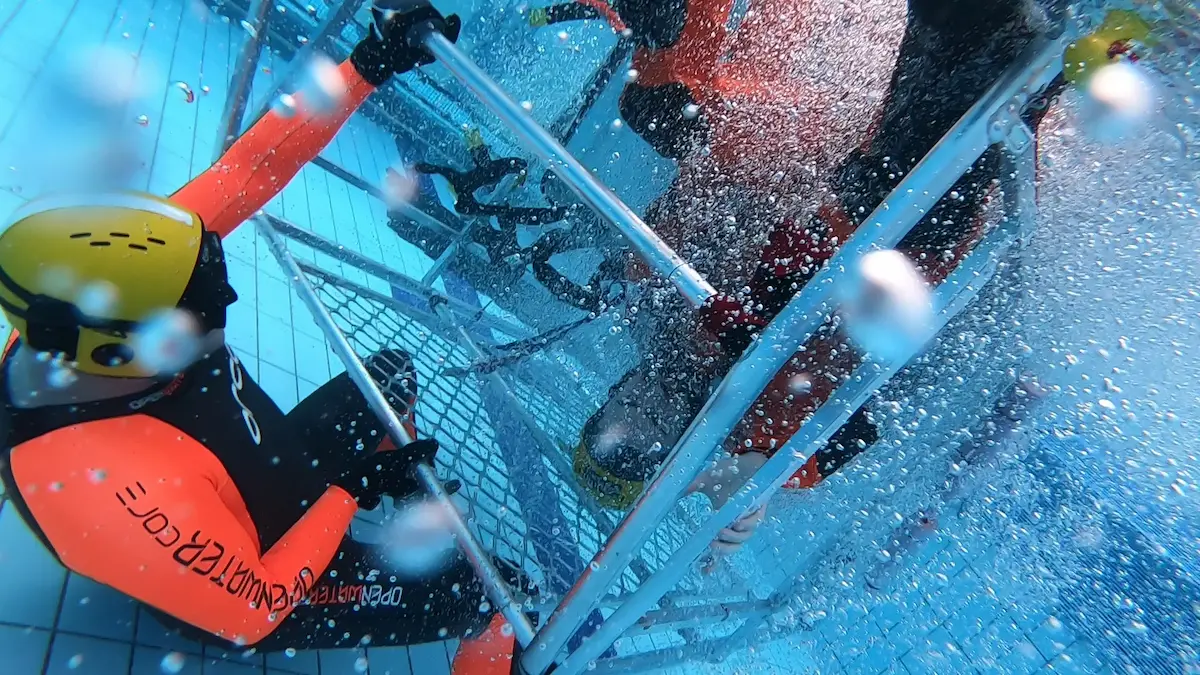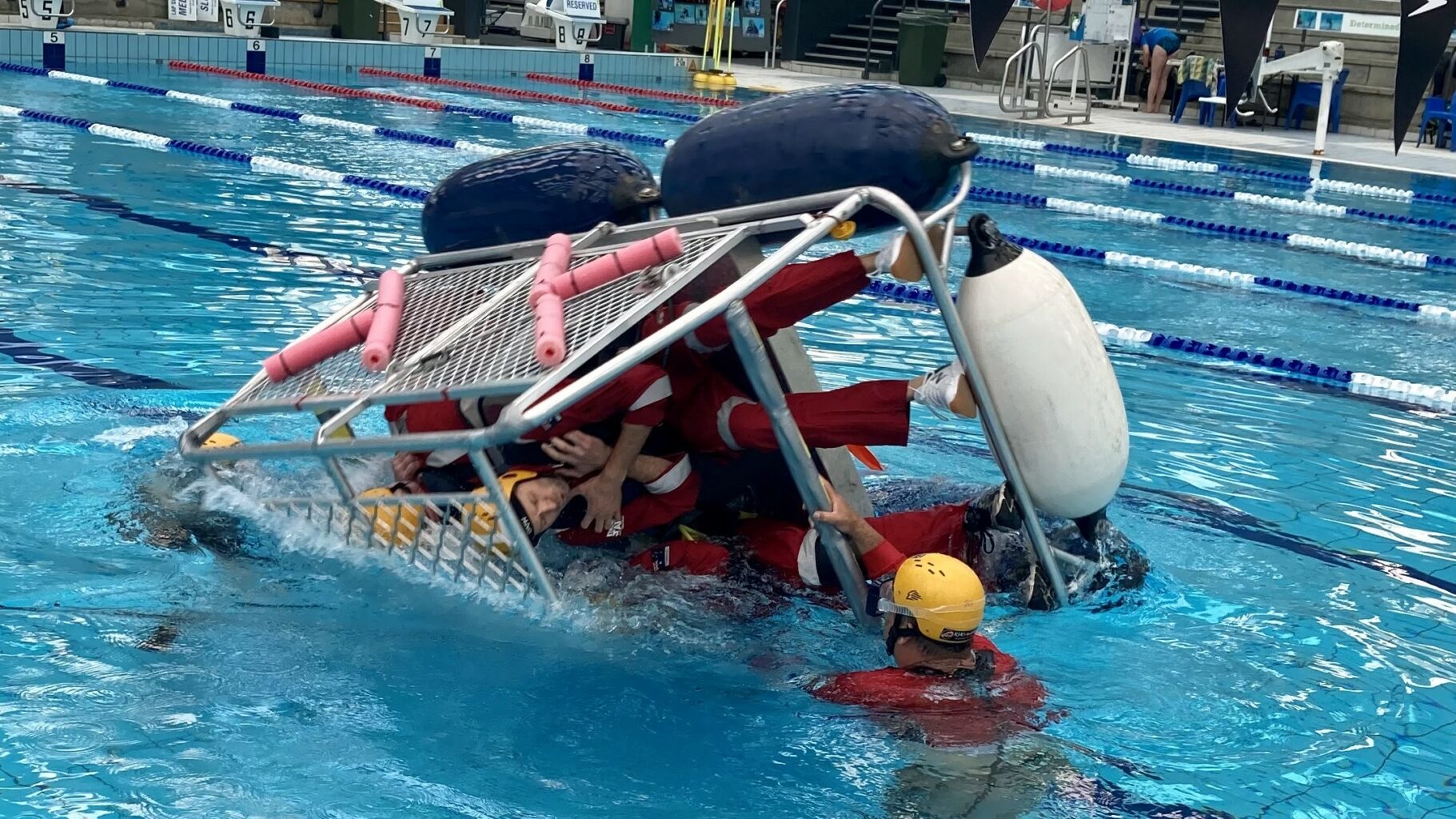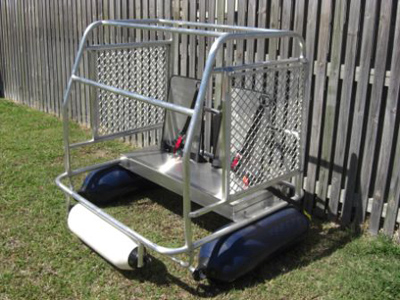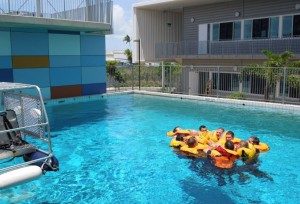Aircraft Underwater Escape Training
AUES (or HUET)

AVIF0038
Course duration: 1 day
Undertake aircraft underwater escape & survival
The course is designed for aircrew and supplemental mission crew.
The AUES / HUET courses RHO Aviation offers are accredited Units of training under the Australian Quality Training Framework. All trainees upon successfully completing the course will receive a nationally recognised Statement of Attainment and an enhanced level of knowledge which may, one day, save their life.
The program has been developed for those aircrew and frequent flying passengers that travel in aircraft over water. The student base consists of commercial, government and military personnel.
Vocational Outcomes
Personnel involved in a ditching face a multitude of hazards. The chance of a crew member or passenger evacuating a ditched aircraft safely and ultimately surviving, is determined by the level and quality of training they have received. Once the student has undertaken this training, the chances of successfully evacuating the aircraft and subsequent survival in the water are significantly increased.
Topics Covered
The following Elements and Performance Criteria are covered on the course:
- Prepare for aircraft ditching:
- Nature and extent of aircraft situation is communicated, and acknowledgement is confirmed
- Personal items within the cabin are secured prior to ditching
- Restraint devices and survival equipment are checked, fastened and secured prior to ditching
- Primary and secondary egress routes, exits and equipment are located
- Brace position is adopted.
- Prepare for evacuation from an aircraft:
- Spatial orientation is conducted
- Egress points are located
- Exits are jettisoned and cleared
- Restraint devices are released
- Aircraft is egressed
- Surface is cleared.
- Conduct rescue recovery process:
- Safety equipment is deployed in accordance with workplace procedures
- Position indicating and signalling devices are deployed
- Rescue recovery techniques are applied.
- Control survival hazards:
- Potential hazards are identified and controlled
- Swimming techniques with a life jacket are applied
- Hypothermia management techniques are employed
- Raft boarding and righting techniques are employed
- Emergency supplies and equipment are managed.
Personal Survival
- Inflate the PFD (lifejacket) in accordance with procedure
- Demonstrate the ability to swim whilst wearing a lifejacket
- Demonstrate towing techniques whilst wearing a lifejacket
- Perform the HELP Position for a duration of 2 to 4 minutes
- Participate in a group huddle
Life Raft Management
- Participate in raft righting & entry
- Participate in immediate/subsequent action drills while in a life raft
Rescue Considerations
- Use the appropriate water entry technique from a height of 1 metre (subject to the training location)
- Demonstrate rescue equipment and procedures for use
- Use the appropriate heli-winching techniques (subject to the training location)
Assessment:
- Theory: Your knowledge of the theory component will be assessed via an online theory component and questionnaire. On successful completion you will proceed on to the practical training and assessment.
- Practical Training: Trainees will be given instruction in underwater escape, rescue and survival procedures in a variety of ditching situations, these include:
- Inverted ditching
- Simulated night time or low visibility escape scenarios
- Exits – normal operation or exit obstructions
- Cross cabin/Secondary exit evacuation
- Life jacket and life raft drills
Emergency Breathing Systems (EBS) Training is gaining widespread usage as an adjunct to HUET. For information on this type of training, click here.

Our procedural trainers



Our Procedural Trainers are the next generation of underwater disorientation devices for aircraft escape training. For they have all the benefits a larger disorientation device has, coupled with the ability to provide direct one-on-one instruction.
Having extensive experience in single-seat disorientation trainers, crane-lowered metal cage simulators and full-sized gantry-raised simulator systems, RHO Aviation decided that there had to be an alternative. The single-seat trainer was too small and limited and in its current design, but easy to transport. The full-sized gantry-raised simulators were expensive and needed a fixed facility. The metal-cage ‘dunker’ was mobile, but still required a pool with crane access.
The solution? A specially-designed multi-seat procedural system with more realistic jettisonable hatches that can be easily transported anywhere in the world and operated by our team of professional trainers. The HeliPET or 4PET (larger type 4 seat simulator) is the answer to your AUES/HUET and EBS training requirements. We can tailor courses to accommodate specific industry requirements supporting your organisation anywhere you are.
RHO Aviation’s 4PET is a larger, totally mobile, procedural trainer (below left). It allows training in more advanced scenarios and is a great supplement to the HeliPET. All procedural trainers have operable jettisonable exits, four-point seatbelts and high back seats. They are excellent simulators for cross cabin/secondary exit training and also emergency breathing system training.